Related Research Articles
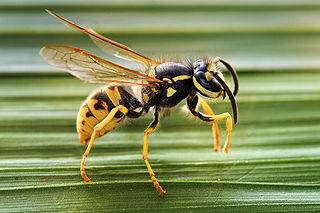
The Vespidae are a large, diverse, cosmopolitan family of wasps, including nearly all the known eusocial wasps and many solitary wasps. Each social wasp colony includes a queen and a number of female workers with varying degrees of sterility relative to the queen. In temperate social species, colonies usually last only one year, dying at the onset of winter. New queens and males (drones) are produced towards the end of the summer, and after mating, the queens hibernate over winter in cracks or other sheltered locations. The nests of most species are constructed out of mud, but polistines and vespines use plant fibers, chewed to form a sort of paper. Many species are pollen vectors contributing to the pollination of several plants, being potential or even effective pollinators, while others are notable predators of pest insect species.

Potter wasps, the Eumeninae, are a cosmopolitan wasp group presently treated as a subfamily of Vespidae, but sometimes recognized in the past as a separate family, Eumenidae.
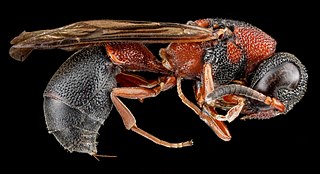
Leptochilus is a large, mostly Holarctic genus of small sized potter wasps. The genus reaches its largest diversity in the Palearctic where there are more than 135 species belonging to 5 subgenera. However the division of The division of Leptochilus into subgenera can not be fully supported and the status of some of them is dubious.
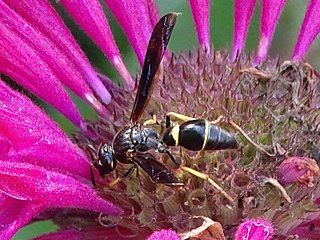
Parazumia is a Neotropical and Nearctic genus of medium to large sized potter wasps. The Nearctic species of this genus have been treated for much of the 20th century as a separate genus named Paranortonia.
Abraham Willink was a Dutch-Argentine entomologist. His main contributions were made on the Hymenopteran families Vespidae, Sphecidae and Crabronidae. He also contributed to the classification of biogeographical provinces of Latin America. His role was of great interest in the decentralization of science, especially in Entomology in Argentina.
3 Genera and 52 species has been named after him.
Pachodynerus is a fairly large neotropical and nearctic genus of potter wasps with higher diversity in central South America. At least one species has been introduced in other biogeographical regions, including several oceanic islands, while Pachodynerus erynnis occurs on Ascension Island as well as in North America. This genus is most closely related to the genus Euodynerus.

Ancistrocerus is a widely distributed genus of potter wasps present in many biogeographical regions of the world. They are nonpetiolate eumenine wasps with a transverse ridge at the bending summit of the first metasomal tergum and with a low and opaque propodeal lamella completely fused to the submarginal carina.
Alastor is a Palearctic, Indomalayan and Afrotropical genus of potter wasps, primarily found in tropical Africa. It is divided into the 4 subgenera Alastor, Alastorellus, Megalastor and Parastalor.

Synagris is an Afrotropical genus of large potter wasps. Several Synagris wasps are strongly sexually dimorphic and males bear notable morphological secondary sexual traits including metasomal lamellar or angular protruding structures and hornlike or tusklike mandibular and/or clypeal projections.
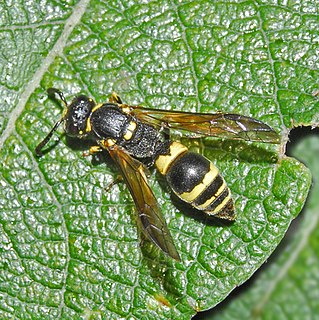
Symmorphus is a primarily holarctic genus of potter wasps.
Postepipona is an Afrotropical genus of potter wasps containing two species, one from Madagascar and the other from island of Socotra in Yemen.
Knemodynerus is a genus of potter wasps distributed through the Palearctic, Afrotropical, Indomalayan and Australasian regions. The species currently classified in the genus are:

Pseudodynerus is a small Neotropical genus of potter wasps currently containing 16 species.
Ischnogasteroides is an Afrotropical and Palearctic genus of potter wasps. It currently includes the following species:
Zethus carpenteri is a potter wasp in the family Vespidae, subfamily Eumeninae native to Venezuela.
Gymnomerus is a monotypic Palearctic genus of potter wasps. The sole species is Gymnomerus laevipes.

Delta emarginatum is a species of potter wasp in the subfamily Eumeninae of the family Vespidae.
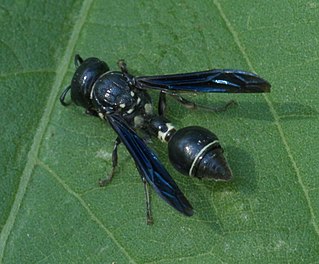
The Zethinae are a subfamily of wasps in the family Vespidae, the members of which are referred to as potter wasps owing to their method of nest construction.

Symmorphus cristatus is a species of mason wasp in the subfamily Eumeninae within the family Vespidae. This species is widely distributed in North America, and it preys on the larvae of leaf beetles.
References
- ↑ A. Willink & A. Roig-Alsina (1998). "Revisión del genero Pachodynerus Saussure (Hymenoptera: Vespidae, Eumeninae)". Contributions of the American Entomological Institute . 30 (5): 1–117.
- ↑ J. M. Carpenter & J. van der Vecht. "Catalog of the Neotropical Eumeninae". American Museum of Natural History . Retrieved July 12, 2011.